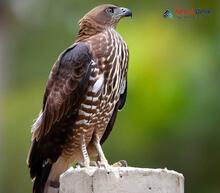We are continually fascinated by the incredible diversity of birds, and the Pernis genus is no exception, as it garners attention from bird enthusiasts. These birds of prey have a shared ancestry, classification, and evolutionary path that differentiates them. In this article, we're going to journey into the captivating world of the Pernis genus, investigating its genetic roots, distinct characteristics, and occurrences in Nepal.
Starting Points and Categorization
The Accipitridae family is home to the Pernis genus, which shares close ties with other birds of prey like eagles, hawks, and kites. French naturalist Mathurin Jacques Brisson first documented the genus in 1760, affirming its longstanding position in scientific writing. As new information about species relationships emerged over time, taxonomists reevaluated and updated this group's classification accordingly.
Evolutionary Connections and Genetic Lineage
Thanks to advanced molecular genetics techniques, scientists can now gain a deeper understanding of the links between different Pernis species. Genetic research has shown that they share a common ancestor with other birds of prey within the Accipitridae family. Though often referred to as "kites," these species possess distinct traits that separate them from their relatives.
Lineup of Species
Currently, five acknowledged species belong to the Pernis genus:
1. European Honey-buzzard (Pernis apivorus)
2. Crested Honey-buzzard (Pernis ptilorhynchus)
3. Barred Honey-buzzard (Pernis celebensis)
4. Red-throated Honey-buzzard (Pernis concolor)
5. Oriental Honey-buzzard (Pernis ptilorhyncoides)
Each species has its own special size, color, and habitat inclinations.
Unique Features
Pernis birds are renowned for their impressive size, with wingspans measuring up to 4.5 feet. They usually exhibit brown or gray feathers, which often comprise elaborate patterns that serve as camouflage. A key characteristic that sets them apart from other birds of prey is their specialized diet – they primarily consume insects like bees and wasps, using their formidable beaks and talons to extract nutrient-rich larvae from nests.
Feathered Residents of Nepal
Nepal's varied ecosystems are home to an assortment of Pernis species, notably the European Honey-buzzard and Oriental Honey-buzzard. Nepal's lush forests, vast grasslands, and numerous preservation areas provide an ideal environment for birdwatchers and researchers to study these intriguing predators in their natural habitat.
In summary, the Pernis genus offers a fascinating glimpse into the rich variety and complexity of birds of prey. By investigating their origins, classifications, and exclusive features, we can gain a deeper understanding of the vital roles these creatures play in maintaining ecological stability throughout their native environments. So if you're a bird lover visiting Nepal or any other area where Pernis species dwell, keep an eye out for these alluring birds as they soar overhead in search of their next meal.




